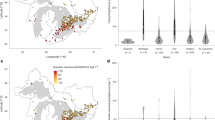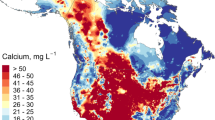Abstract
Rates of acidic deposition from the atmosphere (‘acid rain’) have decreased throughout the 1980s and 1990s across large portions of North America and Europe1,2. Many recent studies have attributed observed reversals in surface-water acidification at national3 and regional4 scales to the declining deposition. To test whether emissions regulations have led to widespread recovery in surface-water chemistry, we analysed regional trends between 1980 and 1995 in indicators of acidification (sulphate, nitrate and base-cation concentrations, and measured (Gran) alkalinity) for 205 lakes and streams in eight regions of North America and Europe. Dramatic differences in trend direction and strength for the two decades are apparent. In concordance with general temporal trends in acidic deposition, lake and stream sulphate concentrations decreased in all regions with the exception of Great Britain; all but one of these regions exhibited stronger downward trends in the 1990s than in the 1980s. In contrast, regional declines in lake and stream nitrate concentrations were rare and, when detected, were very small. Recovery in alkalinity, expected wherever strong regional declines in sulphate concentrations have occurred, was observed in all regions of Europe, especially in the 1990s, but in only one region (of five) in North America. We attribute the lack of recovery in three regions (south/central Ontario, the Adirondack/Catskill mountains and midwestern North America) to strong regional declines in base-cation concentrations that exceed the decreases in sulphate concentrations.
This is a preview of subscription content, access via your institution
Access options
Subscribe to this journal
Receive 51 print issues and online access
$199.00 per year
only $3.90 per issue
Buy this article
- Purchase on Springer Link
- Instant access to full article PDF
Prices may be subject to local taxes which are calculated during checkout


Similar content being viewed by others
References
Shannon,J. D. Regional trends in wet deposition of sulfate in the United States and SO 2 emissions from 1980 through 1995. Atmos. Environ. 33, 807–816 (1999).
Tarrasson,L. (ed.) Transboundary Acidifying Air Pollution in Europe (International Cooperative Programme for the Monitoring and Evaluation of Long Range Transmission of Air Pollutants in Europe/Meteorological Synthesizing Centre-West, 1998).
Skjelkvåle,B. L., Wright,R. F. & Henriksen, A. Norwegian lakes show widespread recovery from acidification; results from national surveys of lakewater chemistry 1986–1997. Hydrol. Earth System Sci. 2, 375–577 (1998).
Driscoll,C. T., Likens,G. E. & Church, M. R. Recovery of surface waters in the northeastern U.S. from decreases in atmospheric deposition of sulfur. Wat. Air Soil Pollut. 105, 319–329 ( 1998).
Summers,P. W. Time trend of wet deposition acidifying potential at five ecological monitoring sites in Eastern Canada 1981–1993. Wat. Air Soil Pollut. 85, 653–658 ( 1995).
Downing,C. E. H., Vincent,K. J., Campbell,G. W., Fowler,D. & Smith,R. I. Trends in wet and dry deposition of sulphur in the United Kingdom. Wat. Air Soil Pollut. 85, 659–664 (1995).
Patrick,S., Monteith,D. T. & Jenkins, A. UK Acid Waters Monitoring Network: The First Five Years (Department of the Environment, ENSIS Publishing, London, 1995).
Jeffries,D. S. 1997 Canadian Acid Rain Assessment Vol. 3, Aquatic Effects (Environment Canada, Ottawa, 1997).
Ford,J., Stoddard,J. L. & Powers, C. F. Perspectives in environmental monitoring: an introduction to the U.S. EPA Long-Term Monitoring (LTM) project. Wat. Air Soil Pollut. 67, 247–255 ( 1993).
Kleemola,S. & Söderman,G. Manual for Integrated Monitoring, Programme Phase 1993–1996 (Environmental Data Center, National Board of Waters and the Environment, Helsinki, 1993).
Stoddard,J. L., Driscoll,C. T., Kahl,S. & Kellogg,J. Can site-specific trends be extrapolated to a region? An acidification example for the Northeast. Ecol. Applic. 8, 288–299 (1998).
Hirsch,R. M. & Slack,J. R. A nonparametric trend test for seasonal data with serial dependence. Wat. Resour. Res. 20, 727–732 (1984).
van Belle,G. & Hughes,J. P. Nonparametric tests for trend in water quality. Wat. Resour. Res. 20, 127 –136 (1984).
Stoddard,J. L., Driscoll,C. T., Kahl,J. S. & Kellogg,J. A regional analysis of lake acidification trends for the northeastern U.S., 1982–1994. Environ. Monit. Assess. 51, 399–413 (1998).
International Cooperative Programme on Assessment and Monitoring of Acidification of Rivers and Lakes. Programme Manual (Programme Centre, Norwegian Inst. for Water Research, Oslo, 1995).
Stoddard,J. L. in Environmental Chemistry of Lakes and Reservoirs (ed. Baker, L. A.) 223–284 (American Chemical Society, Washington DC, 1994).
Galloway,J. N., Norton,S. A. & Church, M. R. Freshwater acidification from atmospheric deposition of sulfuric acid: A conceptual model. Environ. Sci. Technol. 17, 541–545 (1983).
Cosby,B. J., Hornberger,G. M., Galloway, J. N. & Wright,R. F. Time scales of catchment acidification: A quantitative model for estimating freshwater acidification. Environ. Sci. Technol. 19 , 1144–1149 (1985).
Kirchner,J. W. & Lydersen,E. Base cation depletion and potential long-term acidification of Norwegian catchments. Environ. Sci. Technol. 29, 1953–1960 (1995).
Evans,C., Monteith,D. T. & Harriman, R. Long-term variability in the deposition of marine ions at west coast sites in the U.K. Acid Waters Monitoring Network: Impacts on surface water chemistry and significance for trend determination. Sci. Tot. Environ. (in the press).
Driscoll,C. T., Likens,G. E., Hedin,L. O., Eaton,J. S. & Bormann,F. H. Changes in the chemistry of surface waters: 25-year results at the Hubbard Brook Experimental Forest. Environ. Sci. Technol. 23, 137–143 (1989).
Hedin,L. O. et al. Steep declines in atmospheric base cations in regions of Europe and North America. Nature 367, 351– 354 (1994).
Likens,G. E., Driscoll,C. T. & Buso, D. C. Long-term effects of acid rain: Response and recovery of a forest ecosystem. Science 272, 244– 246 (1996).
Lawrence,G. B. et al. Soil calcium status and the response of stream chemistry to changing acidic deposition rates in the Catskill Mountains, New York. Ecol. Applic. (in the press).
Bayley,S. E., Schindler,D. W., Parker,B. R., Stainton,M. P. & Beaty,K. G. Effects of forest fire and drought on the acidity of a base-poor boreal forest stream: similarities between climatic warming and acidic precipitation. Biogeochemistry 17 , 191–204 (1992).
Dillon,P. J., Molot,L. A. & Futter, M. A note on the effects of El Niño-related drought on the recovery of acidified lakes. Int. J. Environ. Monit. Assess. 46, 105–111 ( 1997).
Webster,K. E. et al. Structural features of lake districts: Landscape controls on lake chemical responses to drought. Freshwat. Biol. (in the press).
Webster,K. E. & Brezonik,P. O. Climate confounds detection of chemical trends related to acid deposition in Upper Midwest lakes in the USA. Wat. Air Soil Pollut. 85, 1575– 1580 (1995).
Schindler,D. W. et al. The effects of climatic warming on the properties of boreal lakes and streams at the Experimental Lakes Area, northwestern Ontario. Limnol. Oceanogr. 41, 1004–1017 (1996).
Mylona,S. Trends of Sulphur Dioxide Emissions, Air Concentrations and Depositions of Sulphur in Europe since 1880 (International Cooperative Programme for the Monitoring and Evaluation of Long Range Transmission of Air Pollutants in Europe/Meteorological Synthesizing Centre-West, 1994).
Acknowledgements
We thank the LRTAP Working Group on Effects for their support; this Working Group supports the production of international, quality-controlled, comparable data. We also acknowledge the work of the ICP Programme Centre at the Norwegian Institute of Water Research (NIVA), where the data are collated, verified and archived, and thank T. J. Sullivan and M. R. Church for comments and suggestions. This work was supported by the US Environmental Protection Agency.
Author information
Authors and Affiliations
Corresponding author
Rights and permissions
About this article
Cite this article
Stoddard, J., Jeffries, D., Lükewille, A. et al. Regional trends in aquatic recovery from acidification in North America and Europe. Nature 401, 575–578 (1999). https://doi.org/10.1038/44114
Received:
Accepted:
Issue Date:
DOI: https://doi.org/10.1038/44114
This article is cited by
-
Acidification of freshwater lakes in Scandinavia: impacts and recovery of chironomid communities under accelerating environmental changes
Hydrobiologia (2024)
-
Calcium availability affects the intrinsic water-use efficiency of temperate forest trees
Communications Earth & Environment (2023)
-
Spatiotemporal changes in sedimentary chironomid assemblages across a gradient of lake water pH and metal contamination from the Sudbury (Ontario, Canada) metal-smelting region
Aquatic Sciences (2023)
-
Stream water acidification in the Far East of Russia under changing atmospheric deposition and precipitation patterns
Limnology (2022)
-
Decoupling of chemical and biological recovery from acidification in a montane lake, Vermont, USA
Journal of Paleolimnology (2022)
Comments
By submitting a comment you agree to abide by our Terms and Community Guidelines. If you find something abusive or that does not comply with our terms or guidelines please flag it as inappropriate.



